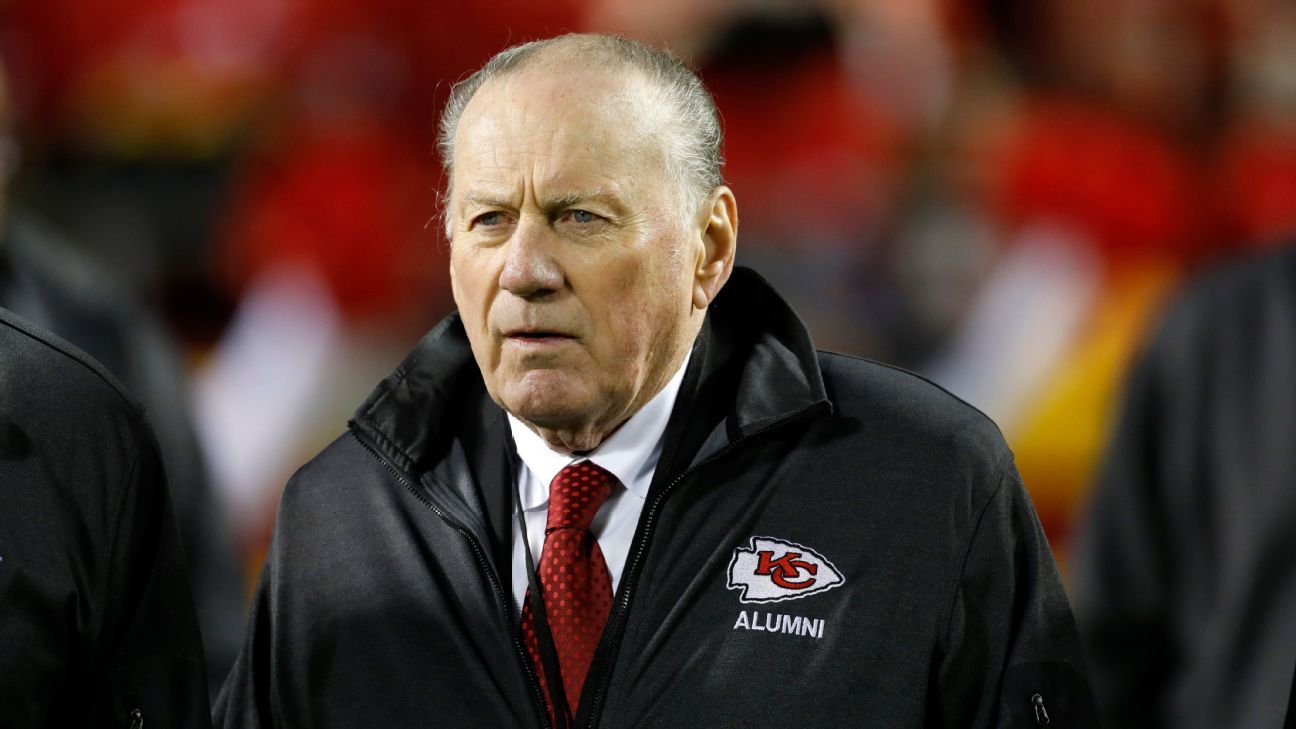Len Dawson, who led the Kansas City Chiefs to victory in Super Bowl IV and was elected to the Pro Football Hall of Fame as both a player and broadcaster, has died at the age of 87, according to his family.
“With wife Linda at his side, it is with much sadness that we inform you of the passing of our beloved Len Dawson,” the family said in a statement to KMBC in Kansas City, where Lawson previously worked as a sports broadcaster. “He was a wonderful husband, father, brother and friend. Len was always grateful and many times overwhelmed by the countless bonds he made during his football and broadcast careers.
“He loved Kansas City and no matter where his travels took him, he could not wait to return home.”
Dawson, who had entered hospice care in Kansas City on Aug. 12, worked for the Chiefs for nearly a half-century: 14 years as a quarterback and 33 as a broadcast analyst.
Chiefs chairman Clark Hunt said he was “heartbroken” about Dawson’s death.
“Len Dawson is synonymous with the Kansas City Chiefs. Len embraced and came to embody Kansas City and the people that call it home. You would be hard-pressed to find a player who had a bigger impact in shaping the organization as we know it today than Len Dawson did,” Hunt said in a statement. “I admired Len my entire life — first as a Hall of Fame player on the field, and later as he transitioned into a successful broadcasting career. Throughout his remarkable career, Len made it a priority to give back to the community that he loved. The franchise has lost a true legend. Our thoughts and prayers go out to Linda and his family.”
Dawson spent the first five years of his 19-season professional career as a sparingly used backup for the Pittsburgh Steelers and Cleveland Browns, but his career took off after he signed in 1962 to play for the AFL’s Dallas Texans (soon to be the Kansas City Chiefs) to play under Hank Stram, who had been an assistant at Purdue during Dawson’s stellar collegiate career.
The man Stram once called “the most accurate passer in pro football” immediately showed he was worthy of being a team’s No. 1 quarterback, leading the AFL in completion percentage (61.0) and earning 1962 Player of the Year honors while carrying the Texans to the league title.
After moving to Kansas City the next year, the team’s success continued under Dawson, who was a seven-time All-Star/Pro Bowler and twice was a first-team All-Pro.
In 1966, he took the Chiefs to another AFL title, which for the first time meant a trip to what would come to be known as the Super Bowl. Dawson played well (16-of-27, 211 yards), but the Chiefs were overmatched by Vince Lombardi’s Green Bay Packers in a 35-10 loss.
The Chiefs were back three seasons later to face the Minnesota Vikings in Super Bowl IV. Despite Joe Namath and the New York Jets upsetting the Baltimore Colts the previous year, the NFL was still seen as superior and the Vikings came in as a double-digit favorite.
But the Kansas City defense dominated and Dawson played a typically strong game (12-of-17, 142 yards), including a 46-yard touchdown pass to Otis Taylor in the third quarter that sealed the 23-7 victory.
Dawson was selected as the second-team quarterback, behind Namath, on the AFL’s all-time team in 1970.
He was elected to the Pro Football Hall of Fame as a player in 1987 and as a broadcaster in 2012, following a TV and radio career that began as a sports anchor on Kansas City TV in 1966 while he was still playing for the Chiefs, oftentimes going to KMBC after practice to broadcast that night’s sports report. Dawson went on to become an analyst for games on NBC as well as a longtime host of HBO’s “Inside the NFL.”
After a series of health issues that included prostate cancer and quadruple heart bypass surgery, Dawson retired from broadcasting in 2017 following 33 years as the Chiefs’ radio color analyst.
Dawson remained a beloved figure in Kansas City, even though he cut back on public appearances several years ago when his health began to fail him. But he always had time for fans, whether it be a photograph or signature, the latter often on an iconic black-and-white photo from halftime of that first Super Bowl: the exhausted quarterback, white uniform caked with mud, sitting on a folding chair with a cigarette in his mouth and a bottle of Fresca at his feet.
It perfectly captured a time and place. And it perfectly captured a man who embodied poise and self-assurance.
Dawson was born June 20, 1935, the ninth of 11 children who filled the house of James and Annie Dawson in the blue-collar manufacturing town of Alliance, Ohio. He was a three-sport athlete at Alliance High School, setting records in football and basketball, and turned his success on the gridiron into a scholarship offer from Purdue.
There, Dawson led the NCAA in passing efficiency as a sophomore while also playing defense and kicking, and he helped lead a memorable upset of Notre Dame during the 1954 season. By the end of his college career, Dawson had thrown for more than 3,000 yards despite playing in an era that favored ground-and-pound football, and was chosen by the Steelers in the first round of the 1957 draft.
He ultimately found success with the Chiefs, and when he hung up his helmet after the 1975 season, Dawson retired with 28,711 career passing yards and 239 touchdowns. All but 204 yards and two touchdowns came with the Chiefs franchise.
Dawson was married to his high school sweetheart, Jackie, from 1954 until her death in 1978, and together they had two children. His second wife, Linda, remained by his side when Dawson entered hospice care.
The Associated Press contributed to this report.
